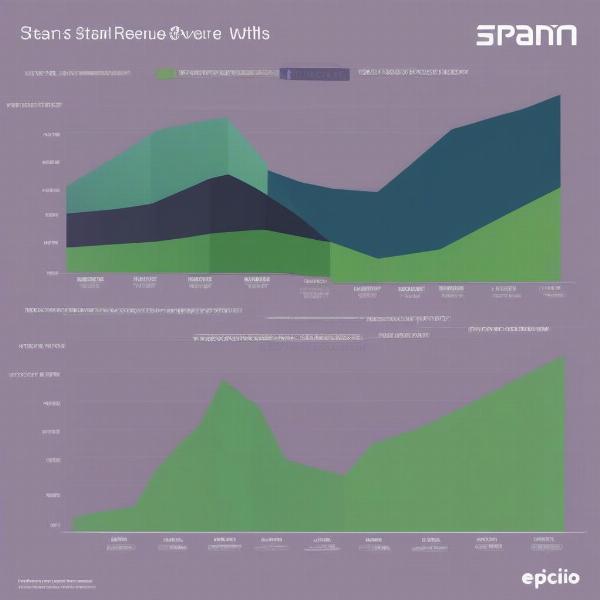Steam’s cut from game sales is a common question among developers and curious gamers alike. Understanding this revenue share model is crucial for both those creating and consuming games on the platform. So, let’s dive into the details of how much Steam actually earns from each sale.
Breaking Down Steam’s Revenue Share Model
Steam’s revenue share model is tiered, meaning the percentage they take decreases as your game sells more copies. This structure incentivizes developers to create successful games and rewards them for hitting certain sales milestones.
Initially, Steam takes a 30% cut of each game sale. However, this percentage drops to 25% after the game earns $10 million in revenue, and further drops to 20% after $50 million. This sliding scale is applied cumulatively, meaning it applies to all sales throughout a game’s lifetime on the platform.
Why Does Steam Take a Cut?
Steam isn’t just a storefront; it provides a whole suite of services for developers and players. These include hosting game files, managing bandwidth, processing payments, providing customer support, and facilitating community features like forums and workshops. The revenue share covers the costs of these services and allows Valve, the company behind Steam, to continue investing in the platform.
Think of it like renting a space in a bustling marketplace. You benefit from the foot traffic and infrastructure the marketplace provides, and in return, you pay a fee. Similarly, Steam provides a massive audience and a robust platform for game distribution, and their cut is the price of entry. This also ties into how you can see how much you’ve paid for your Steam games.
can i see how much i paid for steam games
 Steam Revenue Share Model Breakdown
Steam Revenue Share Model Breakdown
How Does This Compare to Other Platforms?
Steam’s revenue share is generally in line with other major digital distribution platforms. While specific percentages might vary, most platforms operate on a similar model, taking a cut in exchange for providing infrastructure and services. Understanding these differences can be crucial for developers deciding where to publish their games. This is similar to how Steam handles refunds, which you can learn more about in our guide on how to refund Steam games.
Is Steam’s Cut Fair?
The fairness of Steam’s cut is a topic of ongoing debate within the gaming industry. Some developers argue that the 30% initial cut is too high, especially for indie developers with limited resources. Others contend that the services and reach provided by Steam justify the cost, especially considering the potential for reaching millions of players worldwide.
“The tiered model incentivizes developers to strive for success. Hitting those milestones can significantly boost revenue, especially for smaller studios,” says Alex Wright, a veteran game developer with over 15 years of experience.
 Comparison of Steam's Revenue Share with Other Platforms
Comparison of Steam's Revenue Share with Other Platforms
How Do Microtransactions Factor In?
The same revenue share applies to in-game purchases and microtransactions. Whether a player buys the base game or a cosmetic item within the game, Steam takes its respective cut based on the overall revenue generated by the game.
Negotiating With Steam
While the tiered model is standard, there have been reports of larger publishers negotiating special deals with Steam. These deals usually involve a lower revenue share in exchange for bringing highly anticipated or exclusive titles to the platform. However, such negotiations are typically reserved for major players in the industry.
“For most developers, the standard tiered model is the reality. Focus on creating a great game and building a community, and the revenue will follow,” advises Emily Carter, a financial consultant specializing in the gaming industry.
 Impact of Steam Revenue Share on Indie Developers
Impact of Steam Revenue Share on Indie Developers
Looking Ahead
The digital distribution landscape is constantly evolving, and Steam’s revenue share model could potentially change in the future. As competition increases and new platforms emerge, it remains to be seen how Valve will adapt to maintain its position as the leading PC gaming platform. Staying informed about industry trends and understanding the nuances of revenue sharing is essential for both developers and players.
Other Considerations for Steam Game Sales
Understanding the revenue share model is just one piece of the puzzle. Other factors, such as marketing, pricing, and community engagement, play a vital role in a game’s success on Steam. For a detailed breakdown of how to see your Steam purchase history, check out our related article. This information can be helpful for tracking your spending and understanding the overall cost of your game library.
Conclusion
Steam’s revenue share model, while sometimes debated, remains a key element of the platform’s ecosystem. Understanding how much Steam takes from game sales helps developers plan their budgets and set realistic expectations, and it offers gamers insights into the economics of their favorite platform. By grasping the details of this revenue share, both creators and consumers can navigate the Steam marketplace with greater clarity.
FAQ
-
What percentage does Steam take from game sales initially? Steam initially takes a 30% cut.
-
Does Steam’s revenue share change? Yes, the percentage decreases to 25% after $10 million and 20% after $50 million in cumulative revenue.
-
Why does Steam take a percentage of sales? The revenue share covers the cost of services Steam provides, such as hosting, bandwidth, and customer support.
-
Do microtransactions have a different revenue share? No, the same tiered model applies to all in-game purchases.
-
Can developers negotiate with Steam? While larger publishers may negotiate special deals, the standard tiered model is the norm for most developers.
-
Is Steam’s revenue share fair? This is a subject of ongoing debate, with arguments on both sides.
-
Where can I find more information about managing my Steam purchases? You can explore our guide on can i see how much i paid for steam games.

